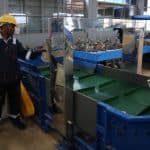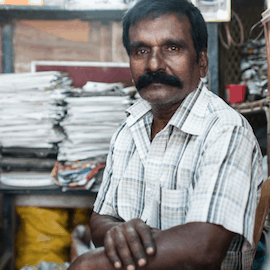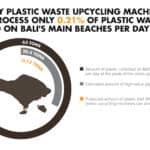Trash Talk: Five Lessons for Reducing Plastic Pollution by Establishing Sachet Recycling Loops
The world produces a staggering 855 billion pieces of sachet waste each year. To make this vast number a little less abstract, this is enough to cover the entire surface area of the world every year.
Coined the “sachet economy,” the market for sachet-packaged products has grown everywhere since the 1990s, and has particularly exploded in emerging economies in Africa and Southeast Asia. Whereas consumer goods companies initially deemed these markets too hard to profitably reach, sachets provided them with the opportunity to sell small, single-use quantities of their products, thereby offering these consumers convenience and product safety at a low purchasing price — a value proposition that proved very successful. Sold in shops, stalls and kiosks, sachets nowadays allow low-income consumers to purchase pretty much everything from shampoo and soap, to coffee, washing powders and powdered milk — along with many other products — on a day-to-day basis.
The sachet economy: a growing environmental threat
Combine the sheer size of the sachet economy with the fact that the multilayered structure of sachets makes them almost impossible to manage and recycle, and it’s easy to see why this economy is quickly creating significant risks for life on earth. With a lack of alternatives to manage sachet waste, the bulk of it is either dumped in overflowing landfills (causing pollution of soils and waterways), sent to incineration (polluting the air with toxic gases, heavy metals and particles, causing global warming and health hazards), or left to contaminate waterways, shorelines and oceans (causing acidification, which in turn triggers systems changes).
While some, like A Planet Plastic co-founder Sian Sutherland, are advocating for a ban on sachets altogether, others are trying to find solutions to the waste issue, even if just to address the mountains of waste that have already been created.
Bangladesh’s struggles with sachet waste and pollution
Along with countries like Indonesia and the Philippines, Bangladesh is a country where sachet waste is becoming an increasingly acute problem. As one of the most densely populated countries in the world, and with an economy that is growing fast, it is experiencing a sharp increase in both plastic use and pollution.
According to The World Bank, the country’s annual per capita plastic consumption in urban areas tripled from 3.0 kg in 2005 to 9.0 kg in 2020. While a portion of this plastic is getting recycled, most of the country’s mismanaged plastic waste consists of single-use plastics like shopping bags, sachets, and other packs and wrappers — types of plastics that are especially hard to recycle. Consumption of these low-density polyethylene packaging materials increased fivefold from 2005 to 2020. Furthermore, an investigation in 2022 found that Bangladesh generates 192,104 tons of sachet waste each year, which means that 129 million sachets are used by its people on a daily basis. As mentioned earlier, these sachets are nearly impossible to collect and recycle, making them a particularly hard-to-manage stream of plastic waste.
Given the current growth rate of difficult-to-recycle plastics, there is an urgent need for practical solutions that help close the loops, to avoid any further degradation of the environment — and any related impacts on people’s health and livelihoods.
Can we create a recycling loop for sachets?
In 2021, a small consortium of business enterprises and not-for-profit organisations entered a collaboration aimed at igniting a larger-scale, market-driven solution to sachet waste. This consortium includes Arla (a dairy producer), Arbab Group (a packaging producer looking to find recycling solutions) and Bopinc (a not-for-profit organisation that accelerates the impact of market-driven innovations in low-income markets, where I work as Circularity and Regeneration Lead).
To advance this goal, with financial support from the Danish International Development Agency and technical support from ReForm, the partnership launched a pilot project to build the technical capacity to upcycle different ranges of sachet waste into higher-value products like construction materials (i.e., panels, boards, poles), furniture, office supplies and more, and to introduce these products into the Bangladeshi market.
After the upcycling facility was developed by Arbab Group, Bopinc and Arla organised and tested a market-driven ecosystem that enables the input provision for Arbab’s new facility. By trialling different ways of collecting pre- and post-consumer sachet waste through different logistical routes, the partners have gained valuable learnings into how to make waste collection more effective and cost-efficient. Finally, Arbab and Bopinc proceeded to design and develop different products that can repurpose the sachet waste into new value, and thereby provide the financial incentive for the entire ecosystem to thrive. The ultimate goal of these efforts is to sell the upcycled products in-country and abroad, in order to create a loop for sachet waste. After two years of designing, developing, monitoring and iterating this pilot project, we learned five key lessons that can be applied by other businesses and organisations working to address sachet waste and other types of plastic pollution in emerging economies like Bangladesh.
Five key lessons for plastic waste management
1: Start with what’s available, and gradually work towards more
Waste is plentiful, but each activity that prepares the waste to become useful as feedstock costs money and eats into the margins of a recycling business. Therefore it is essential to build on and weave together existing structures (such as informal waste picking networks, municipal collection infrastructures and existing logistical chains) to reduce costs. When building business models based on recyclable waste, it’s also important to consider that waste is not only produced after a consumer uses a plastic product. Production facilities and supply chains also produce waste, and this pre-consumer waste is not only relatively clean and ready-to-recycle compared to post-consumer waste, it’s also generally more accessible, as it is already congregated at production sites. Therefore this type of waste can be relatively low-barrier feedstock for recyclers to test with and build up their business capabilities.
As a next step, businesses can focus on recycling post-consumer waste to create more impact. As part of our consortium’s various collection trials, Arla is taking a unique approach to collecting this waste, leveraging its elaborate dairy distribution network which includes many thousands of stores across Bangladesh that sell its Dano Daily Pushti products (a skimmed milk, infused with vegetable fat, that’s the most popular powdered milk brand in the country). As part of these efforts, the company decided to collect its sachet waste through retail shops that sell Arla products, giving incentives to consumers to hand back their used sachets. It organised a reverse logistics system that piggybacks on the existing reverse chains it uses to collect damaged goods, which resulted in a lean and relatively low-cost collection mechanism for sachet waste. Although the pilot only collected Arla’s own products for its first trial, it illustrated the potential of collaborating with multiple big brands that leverage the same retail stores to sell their products — something that could significantly reduce unmanaged plastic waste and any incurred cost of collection quite rapidly.
Aside from reverse chains, there are other options for collecting waste. For instance, it is worth noting that there are more than 200 recycling facilities across Bangladesh. These recyclers are supplied by multiple fine-grained networks consisting of people who are already making a living by collecting and selling higher-value plastics, like PET and HDPE. Piggybacking on the work of these networks could provide a quick way to scale waste collection effectively. However, it’s critical to take into account the opportunity costs of this sort of collaboration, recognising the value of the next-best alternative when a decision is made (i.e., what a waste picker or aggregator is giving up in terms of time-investment if they start collecting low-value plastic waste as opposed to other types of waste). This means the price to pay for low-value waste collection might end up being quite similar to the price paid for other, higher-value types of plastic waste.
2: Effective collection starts out with an easy message, strongly tailored to its receiver
As keeping costs as low as possible is essential to waste reduction efforts, it is important to explore potential ways to enable reductions in costs. It is therefore tempting to request that consumers, businesses and other waste-producing organisations prepare the waste for you.
However, asking consumers to segregate different types of plastics, to take one common example, can be considered a bridge too far for most. And expecting consumers to clean the product may or may not be realistic, depending on the circumstances in which the product is being used and disposed of. As time passes this might change, and these value-adding activities may one day be performed by consumers. But during our different waste collection pilots, the consortium quickly learned that it is essential to understand what people already know, and what they are currently willing and (especially) able to do, in order to facilitate easy collection.
3: Value should outweigh effort — and value can be multifaceted
Within the part of the loop in which waste becomes sellable recycled products, there are several activities that need to take place. Waste needs to be segregated, cleaned and compacted into easily stored bails before it can become valuable feedstock for a recycling process that includes shredding, heating, compressing, moulding and laminating the recycled plastic, and ultimately cutting and constructing it into valuable offtake products. Each of these activities should happen at the right place in the chain, at the right scale to create optimal cost efficiency that allows for the end product to compete with alternative products (such as products made out of virgin plastics). This requires each stakeholder in the chain to carefully monitor cost versus value generated within the wider framework.
But it is important to note that value can be defined very differently by each stakeholder. Waste pickers, who depend on waste for income, tend to make a careful consideration of opportunity costs, creating a strong focus on financial returns. However, consumers who take part in collecting their own waste tend to be more driven by a positive “sense of self,” with some going out of their way to “do what is good for the world” without the need for financial reward. Retailers tend to sit right in the middle, recognising that financial incentives are important, but also focusing more on the long-term benefits of attracting more consumers through positive environmental practices and engaging with them in a meaningful manner. Generally, designing a lean waste collection chain requires a careful analysis of what the “ask” could and should be for each player, and how that affects the different types of incentives that are relevant for that person or organisation.
4: Balance volumes with margin potential
There is no shortage of waste in emerging economies, funders are often focussed on creating measurable impact, and effective operations must often rely on economies of scale. For recyclers, it is therefore tempting to focus on high-volume solutions for selling recycled products. In an early phase of the pilot project, the partners in our consortium wanted to focus on the development of recycled construction materials. However, after carefully analysing the business case, a risk started to become apparent: The cost of the recycled materials we were producing was higher than the cost of virgin materials.
As the entire supply value chain needs to earn an income from their waste-management work, the collection and recycling of plastics, especially sachets, is a relatively costly business. For this reason, it becomes difficult to compete on price, which is a key prerequisite for high-volume markets such as construction materials. As alternatives like plywood, chipboard, medium-density fibre or simply virgin plastics are often cheaper, it is essential to define a value proposition that integrates and builds upon the added value of recycled materials, and secures sufficient margins. In order to do this, our project team started to design furniture, office supplies, entire office designs and other higher-value products that we could sell at prices that would allow the business cases for all stakeholders in the value chain to thrive.
5: Keep an eye on the wider system and be open to collaborations
Building a successful business is often a difficult task, but building a thriving business around sachet waste can be a daunting one. But on the other hand, there are also many who recognise the need for a solution to the issue of hazardous sachet waste. This provides opportunities for collaborations, particularly in the most pressing parts of the business: the sourcing of proper feedstock (i.e., plastic waste), and the creation of offtake (i.e., selling recycled products). In Bangladesh, various fast-moving consumer goods (FMCG) companies have asked Arbab to help provide a solution to their sachet waste issue, and most of these FMCG companies seem willing to invest into the solution.
Municipal waste collection centres, schools, businesses and non-governmental organisations have also expressed interest in supplying plastic waste for recycling. But more importantly, a growing list of public and private organisations have expressed interest in purchasing the recycled products created from these materials, to properly close the loops on sachet waste. Arla has been a frontrunner in these efforts by ordering office supplies that are made by recycling their own sachet waste, while other (mostly FMCG) companies have also placed orders for office supplies and furniture. The key to the success of these collaborations has been the co-creative processes between partners, whereby products have been created together.
As the experiences of our consortium’s initial project show, it is possible to profitably combat the challenge of sachet waste in emerging economies. The goal is clear: Now is the time for more development and business sector stakeholders to invest, and work together to reach it.
Rolph Droste is the Circularity and Regeneration Lead at Bopinc.
Photo courtesy of Bopinc.
- Categories
- Environment, WASH



